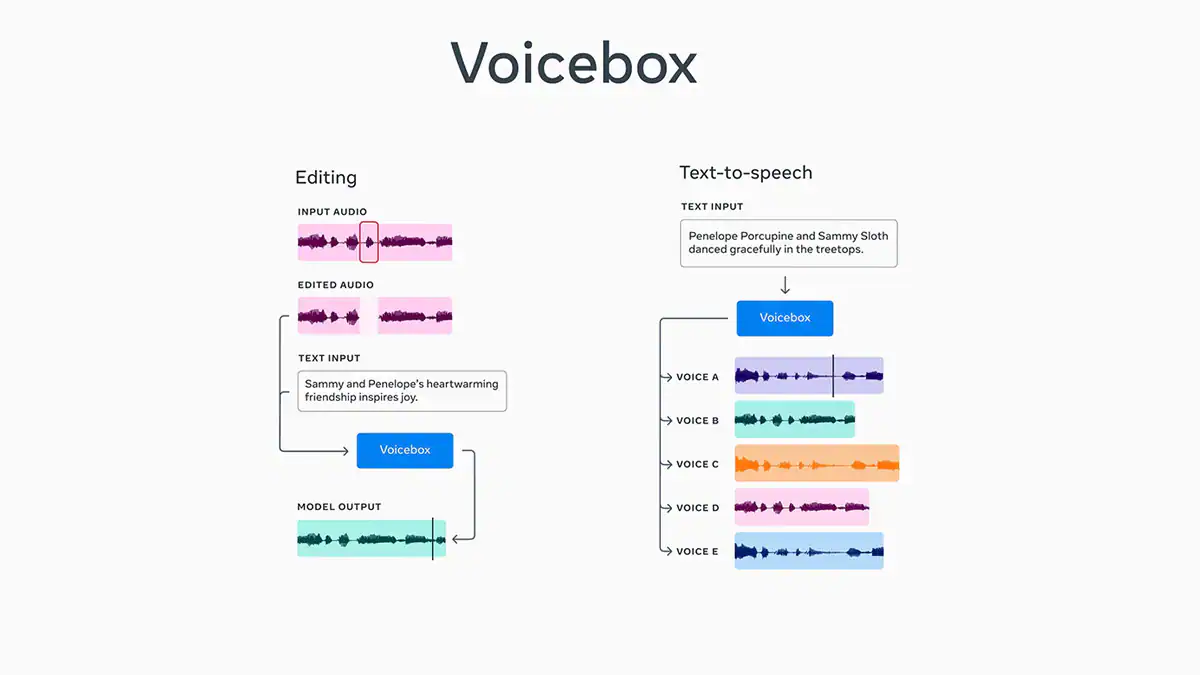Voicebox AI API TTS Pricing Decoded: Cost Guide & FAQs

How Does Voicebox AI API Model TTS Pricing?
When it comes to understanding the TTS pricing model for Voicebox AI API, the key factors include usage metrics, the diversity of voices, and language options offered. The service has a consumption-based model where costs are primarily determined by the volume of text processed and the selected voice types, with options ranging from standard to more advanced, nuanced voices. For developers working on everything from mobile apps to gaming platforms, the Voicebox AI API provides a scalable solution that aligns with project budgets, ensuring that creators can forecast expenses and manage resources effectively without compromising on quality.
Moreover, the Voicebox AI API offers flexibility with a free tier for beginners, making it accessible for those taking their first steps in AI-powered TTS integration. The platform’s commitment to providing high-quality text-to-speech synthesis at a transparent cost empowers developers and firms to innovate and enrich their applications' user experience. As Voicebox AI continues to evolve, incorporating the latest advancements in AI and machine learning, it remains a valuable asset for creating personalized and engaging auditory content that stands out in today's competitive tech landscape.

| Topics | Discussions |
|---|---|
| Voicebox AI API Overview | Delve into the foundational aspects of Voicebox AI API, understanding how this powerful tool can aid in creating rich, natural-sounding TTS experiences. |
| Components Affecting Voicebox AI Pricing | Decipher the elements that determine the pricing structure of Voicebox AI, including usage monitoring and how voice variety affects costs. |
| Voicebox AI API Pricing Structure | Glean insights into Voicebox AI's TTS pricing, which fosters accessibility through a pay-as-you-go model, catering to projects of all sizes. |
| Voicebox AI Developer Tutorials | Discover comprehensive tutorials that pave the way for seamless Voicebox AI integration into your applications using popular programming languages. |
| Maximizing ROI with Voicebox AI | Learn the best practices for leveraging Voicebox AI's features effectively, ensuring your investment yields the highest return. |
| Common Questions Re: Voicebox AI API | Access a curated selection of frequently asked questions, providing clarity and valuable insights into the use and optimization of Voicebox AI API. |
Voicebox AI API Overview
Entering the realm of Voicebox AI API brings a suite of exciting possibilities for dynamic text-to-speech (TTS) applications. Whether you are a fledgling developer or a seasoned engineer, understanding the terminology associated with this technology is crucial. From the intricacies of integrating APIs to the nuances of voice selection, a glossary of key terms lays the foundation for a solid grasp of Voicebox AI's capabilities and prepares you to harness its full potential in your projects.
API (Application Programming Interface): A set of protocols and tools for building software and applications, facilitating communication between different software components.
TTS (Text-to-Speech): Technology that converts written text into spoken words, providing a voice to digital content.
Usage Metrics: Quantitative data that measures the extent of use of a service, such as the amount of text processed by a TTS API.
Voice Selection: The process of choosing from various voice types offered by a TTS service, such as different accents, genders, or languages.
Pay-As-You-Go Model: A pricing strategy where the cost is based on the actual amount of resources consumed by the user, as opposed to a flat rate.
Free Tier: A service plan that allows users to use a TTS API without charge up to a certain limit, providing an entry point for evaluation or small-scale use.
Components Affecting Voicebox AI Pricing
Understanding Usage Metrics
The cost of using Voicebox AI API is highly influenced by usage metrics such as the volume of text to be converted into speech. Pricing is typically calculated on the amount of text processed, emphasizing the importance for developers to track and manage their text submissions to the API. Here are key points to consider for controlling usage and cost:
- Keep track of the character count in each request to monitor and predict expenditures.
- Efficient coding can reduce the amount of text sent to the API, thus managing costs.
- Regularly review your usage reports available through Voicebox AI's console to adjust your usage according to your budget.
Voice and Language Selection Cost Considerations
Another pivotal factor in the cost of Voicebox AI API is the selection of voices and languages for your text-to-speech needs. While more standard options might be included within the base price, specialty voices, or additional language support might incur extra charges. Key considerations include:
- Test different voices to determine which best suit your application while keeping an eye on how they affect pricing.
- Consider user demographics and preferences when selecting languages to ensure a match with your audience's expectations.
- Stay informed about any potential cost implications associated with using premium or specialized voices.
Voicebox AI API Pricing Structure
The Voicebox AI API adopts a transparent and user-centric approach to pricing, making it accessible for a diverse range of projects and applications. This structure tends to follow the pay-as-you-go model, allowing users to pay for the exact volume of text processed into speech. The benefit of this model lies in its scalability, making it just as suitable for small indie developers as it is for larger enterprises with extensive TTS requirements.
Within the pricing framework, certain features like different languages, voice types, and access to advanced AI features may be priced differently. A comprehensive understanding of how each component influences the cost can lead to more informed financial planning and better budget management. Developers can start with a free tier offering a limited number of text processing credits, providing a cost-effective way to experiment with and evaluate the API's capabilities before scaling their usage.
Voicebox AI Developer Tutorials
Integrating Voicebox AI with Python
Python developers can streamline their workflow by integrating Voicebox AI into their projects. The process involves setting up authentication, typically done through API keys, and then using Voicebox AI’s Python SDK to make API calls. These calls instruct the service to convert text input into audio output. It's recommended for developers to follow the well-documented steps provided by Voicebox AI, including best practices for error handling and resource management.
Developing with Voicebox AI in Java
Java remains a robust choice for integrating TTS functionalities, and Voicebox AI's compatibility with Java makes it a strong candidate for enterprise applications. Utilize the SDK to handle all the heavy lifting, from initiating service calls to processing the audio outputs. The Java SDK for Voicebox AI is designed to be flexible and intuitive, allowing for seamless integration into various Java-based application architectures.
Voicebox AI JavaScript Implementation
Leveraging Voicebox AI within web applications or Node.js backends is facilitated through its comprehensive JavaScript SDK. Developers can tap into the versatility of JavaScript to create responsive and interactive web experiences with Voicebox AI's TTS service. Customizable options, including various voice characteristics and language selections, are readily accessible within the developer toolkit, ensuring that incorporating voice capabilities is as simple as possible.
Utilizing Voicebox AI via GitHub
For those looking to contribute to or modify the existing capabilities of Voicebox AI, its presence on GitHub offers a gateway to collaborative development. GitHub repositories related to Voicebox AI open up access to source code, community-developed features, and comprehensive documentation that supports an open-source approach to improving and personalizing the TTS service.
Maximizing ROI with Voicebox AI
Achieving a high return on investment (ROI) with Voicebox AI involves a strategic approach to leveraging the API's features. Efficiency is crucial—optimizing the text sending process can result in significant cost savings. Developers should seek to economize on the API's use by pre-processing text to remove redundancies and utilizing caching mechanisms for repeated requests.
Understanding the finer details of the pricing model also plays an essential role in maximizing ROI. Developers can take advantage of the free tier for initial trials and development, then scale up as needed. Monitoring tools provided by Voicebox AI can help keep track of usage and ensure that projects stay within budget, enabling developers to forecast costs accurately and manage resources to get the most value out of the service.
Common Questions Re: Voicebox AI API
API Possibilities: What Can Voicebox AI Do?
Voicebox AI offers a robust API for text-to-speech services with a diverse range of voices and language support aimed at enhancing user experience with high-quality audio in applications.
Legalities and Ethical Use of AI Voice Technologies
The use of AI voice technologies like Voicebox AI is legal, provided it's used ethically and in compliance with copyright laws and privacy regulations.
Complimentary Access to Voicebox AI: Is It Available?
Voicebox AI may offer free access or trial periods to explore its features and capabilities, which serves as an excellent opportunity for developers and creators to experience the service.
Personalized Voice Generation: Can Voicebox AI Mimic My Voice?
Voicebox AI is capable of generating personalized synthetic voices, potentially allowing users to create a digital voice similar to their own.